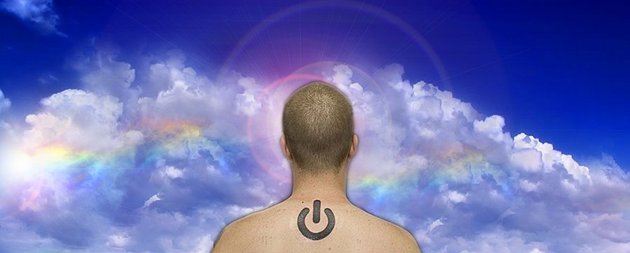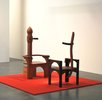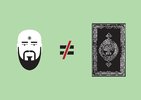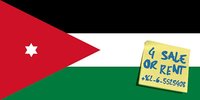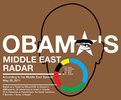Platform for discussion 004
With the benefit of hindsight, what role does new media play in artistic practices, activism, and as an agent for social change in the Middle East and North Africa today?
Essays
-
For the Common Good28 February 2013
Artistic Practices, Collective Action and Civil Society in Tunisia
Anthony Downey
-
On Revolution and Rubbish29 January 2013
What has Changed in Tunisia since Spring 2011
Timo Kaabi-Linke
-
Citizens Reporting and the Fabrication of Collective Memory2 November 2012
Jens Maier-Rothe
-
The Paradox Of Media activism2 November 2012
The Net is Not a Tool, It’s an Environment
Franco Berardi
-
Common Grounds2 November 2012
Artistic Practices, Civil Society, and Secular Determination in Tunisia Today
Anthony Downey
Interviews
-
Breaking Glass22 April 2013
Monir Shahroudy Farmanfarmaian in conversation with Stephanie Bailey
Stephanie Bailey
-
From Invisible Enemy to Enemy Kitchen29 March 2013
Michael Rakowitz in conversation with Anthony Downey
Anthony Downey
-
The Art of Subversion28 February 2013
Caveh Zahedi in conversation with Stephanie Bailey
Stephanie Bailey
-
The Video That Exploded2 November 2012
Roy Samaha in conversation with Anthony Downey
Anthony Downey
-
Fragments of Home2 November 2012
Jeanno Gaussi in conversation with Dorothea Schoene
Dorothea Schoene
-
Running the Territory2 November 2012
Guy Mannes-Abbott in conversation with Sheyma Buali
Sheyma Buali
-
Stereotyping the Stereotypes2 November 2012
Tarek Al-Ghoussein in conversation with Anthony Downey
Anthony Downey
-
Workshopping the future2 November 2012
Shady El Noshokaty in conversation with Omar Kholeif
Omar Kholeif
Projects
Responses
Some artists in these parts of the world began using new media in their work in the 1990s. This happened for a number of reasons but the most important one, I believe, was that of reaching the general public, which was far from being interested in art. In this respect,...
'Networks have no inside, only radiating connectors. They are all edges. They provide connections but no structure. One does not reside in a network, but rather moves to other points through the edges'.
Bruno Latour, 'Some Experiments in Art and Politics', e-flux journal, 03/2011.
With the benefit of hindsight, one should have realised that we exist in what some thinkers have dubbed a 'stationary state'. The stationary state is the condition of non-growth and the incapacity of the world economy to renew itself in order to move towards a new era of accumulation. It asserts that neoliberal capitalism will continue to be what shapes the socio-political landscape – from an economic perspective – for a long time to come, but just as it is, there will be no end in the foreseeable future to the current crisis where capitalism will emerge stronger and fairer. While this condition delineates our possibilities, we have also come to realise the rise in social antagonism as an evident and continuously present element within many societies; constant every day antagonisms based on ideologies, perceived identities, histories, or class. Art's challenge today is to exist and be practiced meaningfully within this static 'longue durée' of the economic order that resists all the antagonisms that can be thrown at it. Facebook, Twitter, You Tube etc. are the networks that have no inside yet are connectors, using Latour's vocabulary. It is no coincidence that they are seen as essential networks during this stationary condition, since there is a general inability to develop new socio-political and economic concepts that can shape the world differently. Because these networks have no inside, they can be filled up with all types of stuff from extremism, terrorism, fascism to leftist, anarchist, and the newer, less-defined movements. In short, they are playgrounds for antagonism in an epoch that is looking for something but has yet to formulate the proper structure for it to exist.
Shining a spotlight on something in order to 'make it visible' is a task indeed. It does not only entail personal and professional risk but also demands courage and responsibility. The ethics of monstration (on behalf of those whose intention is precisely that - to make sense of vision, to give sense to the invisible) comes from a 'monstrous' viewpoint: the viewpoint that designates each image in its form of monstrance (or pattern) and endows each image with quality and power of display.

Selçuk Artut. Courtesy of the artist.
A video by Ali Cherri.
New media has played a role in artistic practices, activism and social change for a long time, and we are increasingly seeing artists using and manipulating images from mainstream media and circulating them online to elucidate political causes.
Digitised media in the last decade has undoubtedly been propelled by the enormous speed of new technology and spontaneous platforms for rights, defined by Hakim Bey as 'Temporary Autonomous Zones' and 'network guerrillas' by Ozgur Uckan. Consequently, despite the mediated content of the mainstream media, social media sites have emerged as powerful tools and driving forces for the democratisation process in the region. On the other hand, and at an ever increasing pace, Turkey has become subject to Internet filters, various forms of censorship in the media, and irrational criminal accusations against online platforms for alternative voices.
Using new media tools and technologies available today has become standard practice for a range of activities; it's become a source of educational content and entertainment, as well as a means of communicating from conflict zones or even from the comfort of our homes. New media technologies available on smart phones and computers are so readily available that bloggers, journalists, artists, authors and others able to use them to record, track and distribute personal content. Drawing on the same reservoir of openly accessible material, users often remix and share media that bear little distinction to one another. It can become difficult to decipher what distinguishes artists' limited edition video montages, for instance, from those created by an everyday user of the technology who doesn't identify her/himself as an artist.
Artists have for some time been using new media to investigate and question their mainstream socio-political environments. In Arab countries, the revolutions that took place are a direct expression of this process's shift from the art community to the mass, from the artist to the public. It was a mutation from the creative field to the cultural field. This shift marks a pivotal point for art dealing with new media. In this new configuration, artists faced a new challenge, one that involved avoiding falling into propaganda-stimulated art practices. They had to choose between being a questioning creative or an answering activist. It became much more delicate when artists became involved in the revolution; art that is based on aesthetical judgment values became applied to ethical problems, and this was problematic. In violent contexts, applying such values to people's suffering could be viewed as fascism. To overcome this paradox, many new media artists refrained from making art at all; others became activists and laid on the definition of activism as art strategy, while others oriented art into Utopian models where symbolic and imaginary refuges are reflected.
When we talk about media, whether we consider them old or new, and critical practices, whether we label them as artistic, activist or hybrid, we would do well to look at issues of embodiment, and where virtual presence and physical presence intersects. The Arab uprisings have shown that no matter how much presence one can wield on the twitter and blogosphere, one has to physically put one's body on the line – collectively – in order to effect change. Technologies are never inherently revolutionary; they can be used for control and for dissent, and while no one can deny the impact of social media as a tool for rallying support, citizen journalism and globalising a cause, technologies are never in and by themselves substitutes for vision, ideas and courage. Social media are performative media, and are thus never representative of a population or a society. Who has a voice on these platforms and is therefore represented, and who is ignored, and therefore does not exist? We need to critically uncover these dynamics if we are to see past the telegenics of the Arab uprisings, and try to understand the lengthy processes ahead. We should also take heed not to be seduced by the immediacy and easy commodification of web 2.0 technologies in terms of clickable activism, 'I-tweet-therefore-I-am' op eds, and revolutionary art exhibitions. Life cannot be contained in 140 characters, and nor can art.
A significant component of Sada's programming provides seminars, lectures, and workshops to young, emerging artists and students in Baghdad. We do this using basic Internet connection, Skype, some simple software, and a projector. A private Facebook group is the site of extensive conversations, critique and debate. This was not done out of an interest in exploring distance learning or online curriculums, but because Baghdad was, and remains, too dangerous and unstable to bring 'visiting' artists or professors into the city. There were two options: ignore the urgent needs, isolation, and violence being faced by these artists until the security situation improves, or find an alternative way to support the development of rigorous work emerging from this period of Iraq's radically shifting and complex history – work that takes on heightened importance given the systemic suppression of images, stories, and information by Iraqi, American, and multi-national forces over the past decade.
Projecting Arabic-speaking artists and professors into a classroom in Baghdad has been an ongoing experiment. It is an imperfect solution, but one that has allowed Sada to build a community of practitioners that can and do connect in the 'real' world in multiple ways. This technology has also enabled programming to take place in a capital where, for all intents and purposes, the potential of work being undertaken by the next generation of artists living in the city today has been largely ignored.
Is this a use of new media as an activist action? I'm not sure if it matters.The idea of a separation, or maintaining this distinction between artists and activists sustains a false notion that there is a fixed line between the two. When did it become acceptable to ignore the fact that for many, the work of being an artist is itself an activist action, leading to works that emerge from context and period?
In the context of Baghdad, when does your work become 'activist'? Is it when you choose to continue painting, regardless of the fact that you have been kidnapped, beaten in front of your family, and threatened for creating work at the age of 22? Once you've travelled through multiple military checkpoints every day for six years to get to art school? Or is it activism only once an artist makes a work that is somehow defined as 'political', even if the 'political' has become as ordinary as the still life of an apple? Are curators activists when they include a few unfortunate cities in exhibitions whose shelf life rivals a milk carton? Or does it graduate from activism once a market is established that approves, appropriates, and/or monetises these expressions?
More useful, I'd imagine, than focusing on the categories of politics during the 'Arab Spring', is a sustained undertaking of the politics of production, access, and the possibility of practice itself for those who do not have the desire and /or opportunity to leave the cities they live and practice in.
Can the subaltern tweet? asked Lisa Nakamura, in response to the formulation 'social media caused the Arab Spring'. If Spivak famously deconstructed the promotion of democracy by supremacist means, Nakamura and others subsequently dismantled the digital orientalism latent in rhetoric suggesting that a US twittersphere galvanised Arab revolutionaries against Arab dictators. Networked media not only yielded conditions for revolutionary communiqués but also digital surveillance and arrests, via monitoring technologies provided by US contractors and companies. Further, online activism only partially represents a movement including in-person organising across classes and political affiliations (such as student groups, a militant industrial labour movement, the Muslim Brotherhood, etc.)
Promoting a tweeted uprising appears at least partially within the structure of western mediagenicity, its iconic images of youth and revolutionary picturesque. A sudden 'event' of insurrection reads legibly to viewers abroad, but is insufficient to explain complex political movements sustained across decades in uneven swirls, whose organising, conversations and tactics can neither be captured nor fully clarified by social media. The originary role attributed to web 2.0 misunderstands communication at its heart, assuming a perfect relay of cause and effect, message and receipt, speaker and context. Such accounts of transparent transmission are blind to structural dissonances between political representation and its appearance as portraiture. Rather, the medium of revolution is necessarily, I think, a scrambled affair, its clarion call sounded by competing interests, themselves prone to drift and projection.
New media's role as an agent for social change in the MENA region has been somewhat sensationalised by mainstream media in referring to recent incidents of unrest as 'Facebook' or 'Twitter revolutions'. Whether used for the purpose of social exchange or as part of an artistic practice, real-time communication and the immediacy of messaging creates the potential for a 'political' space (often further developed through other kinds of sustained action) in which voices and images can be shared outside official media channels. At the same time, as media analysts have pointed out, the way in which media and information are regulated, accessed and distributed, continues to vary according to the specifics of place and context.
Art and activism itself is an often fraught topic that has received heightened attention in recent biennials, as well as in numerous exhibitions and conferences profiling a range of approaches – from direct political commentary to practices that deal with risky or unstable positions and systems of authority through tactics of ambiguity, satire, the quasi-fictional, subterfuge or infiltration. Similarly, the ways in which art, new media and activism in the MENA region intersect encompass a range of organisational and individual practices that vary in intention and scope. An extensive overview is not possible here, but organisations such as the Cairo-based Mosireen, who were, they say, 'born out of the explosion of citizen media and cultural activism' during the Egyptian revolution, see digital media as a way of empowering citizen journalism through publishing, workshops, documentation and dissemination, while organisations such as Ashkal Alwan in Beirut continue to support vital artistic, educational and media-based initiatives that are framed by an engagement with civil society.
With the current tendency in media coverage to focus on the topic of unrest, it is important not to generalise or stereotype individual artistic practices. While a work such as Rabih Mroué's The Pixelated Revolution (2012) engages with the phenomenon of real-time coverage of the Syrian revolution, it generates critical conversations not only around the 'aesthetics' of violence but also the larger question of how we consume and process images within media culture today. For many artists in the region who are conscious of their role but do not define themselves as 'activists', the use of new media is often part of a larger set of interests such as theatre, performance, and narrative that are intrinsic to their practice and should not be overlooked.
One of the more important aspects of the uses of new media and in particular social media is the emergence and visualisation of online communities. These participant groups have utilised the tools offered by social media sites, such as the creation and exchange of user-generated content, to inform and influence the communities that sites like Facebook have enabled.
Facebook wasn't designed with artists in mind, yet the innumerable methods artists use to incorporate social networking into their practices astonish me. In employing Facebook, Twitter, Tumblr et al, artists dispense a measure of creative control to the deterministic approaches employed in the development of networking platforms.
Social networking sites have instigated an over-determined standardisation in the culture of information technologies. Simultaneously they've offered tools and developed networks to simplify and accelerate data distribution, empowering artists to disseminate their ideas and manage their own promotional strategies.
Live streaming and real time status updates have allowed users to create and follow sometimes banal, often emotive, political and personal narratives, unexpectedly mobilising communities to politicised action.
Content generated and shared online by protesters has exposed a culture of bias and propaganda perpetuated by news journalists, contributing to the destabilisation of governments and problematising the authority of both print and broadcast media.
In a liberal framework, artists are obliged to perform the role of activist, negotiating institutional structures and instigating organisational reform. Parallel to the development of new media technologies, artists have devised manifold potential technological substrates for their ideas as well as multiple exhibition platforms. However, artists' uses of new media networks have left the scantly-regulated organisational structures that art markets operate within relatively unaffected.
As an architecture of interaction, social networks are not just technical but experiential. They encourage participation and in the normalisation of multiple pseudonyms, facilitate a mode of relocation, distancing work from the preeminence of authorship and the primacy of objects.
Visualising complex representations has enabled multiple sites of user identification, rejuvenating dialogues on the role of the artist and the individual in relation to identity, community and economy. It is in these moments of fantastical uncertainty that online networks, as proposed spaces for egalitarian exchange, generate potential through fluctuation, encouraging flux through a continual redefinition of meaning.
The state of the Internet, or more specifically, the state of 'online surfing' is similar to that of dreaming; things leach into each other according to a logic that does not belong to us and cannot be correlated to our chronological time; images are constantly morphing into ghosts of other images of other images of other images. Nostalgia is no longer possible – how can one feel nostalgic towards a mediated dream?
An obsession with separation between the online and the offline is a paranoid attempt to prevent our world from flooding. Obviously, one cannot think of the Internet as merely a tool, while ignoring the fact that tools are not neutrally passive, but have their own presence and tendencies, their own structures of control and belief systems embedded in their basic protocols. The impact of the Internet on art is far beyond art that exists online or that specifically deals with the Internet; it is fundamentally changing the way art is created, experienced and circulated, within an attention economy. However, such impact is in no way positive or negative, nor is it a radical novelty. It is what it is, and thus the actual question becomes, as an artist: How to integrate such awareness to further one's own work and interests?
vs. The Ruler was made during the first year of the Arab uprising. It is comprised of two custom-made wooden 'electrocution' chairs (thrones) sitting in opposition to each other. The patriarchal male throne suggests the military and religion. Its counterpart is also suggestive of Islamic architecture,...
The digitally mediated world operates as a gigantic magnet for centralisation, regulation and control by giving shape to our lives, our languages and bodies. This means that the digital domain is increasingly becoming the very location of politics. I propose the term 'magnetic' as an invitation to re-think audio-visual artwork as generating alternative electric currents and thus attracting alternative forms of flows through mobile elements and/or social connectedness in the age of digital culture. An audio-visual artwork can behave like a magnet either pulling things and people towards each other or pushing them apart.
In Negotiations 1972-1990, Gilles Deleuze says: 'Indeed, I think subjectification has little to do with any subject. It's to do, rather, with an electric or magnetic field, an individuation taking place through intensities (weak as well as strong ones), it's to do with individuated fields, not persons or identities. It's what Foucault, elsewhere, calls "passion"' (p.97).
In my conception, the term 'magnetic' therefore refers to a particular sort of potentiality, the potentiality of the co-existence of 'mobile elements' (objects, bodies, sounds, voices) that operate like magnets so as to produce a plural form, and thus requires another kind of material practice and another kind of spectator/listener. The 'magnetic' exists as the exception to what there is, as an addition to what is available – that is, to bodies and languages that have been endlessly produced and re-produced by the forces of the globality.
Today, collaborative and participatory art practice as well as installation and public art performance can facilitate a magnetic field of its own as emerging as a social form through participation. Sound installation 191/205 (2009) by Asli Cavusoglu, for instance, engages us with remix and DJ culture. In collaboration with MC Fuat, a hip hop singer and song-writer, Cavusoglu made a song using 191 of the 205 words banned in 1985 by the General Directorate of the Turkish Radio and Television Corporation (TRT) from TV and radio broadcasts on the grounds that they did not comply with the 'general structure' of the Turkish language. In this context, audio-visual artwork appears to be considered in terms of its effects rather than its material presence. The effect is about composing (social) forms, not about the composed (social) forms. It is about giving force to feelings, perceptions, sensations as well as actions, movements, restoring our relationship with the existing and given world.
I treated a young homeless kid to some tea at the local coffee shop one morning and asked him how he usually spent his day. He told me he would hang out on the street, ask people for money so that later in the evening he would go to the...
I Think I Love You is an installation of oil paintings produced by art workers in Dafen, China. Paintings are crafted as replicas of a single, publicly-distributed image of His Highness Mohammed bin Rashid Al Maktoum, Prime Minister and Vice President of the United Arab Emirates, and constitutional monarch of Dubai. Each painting is ostensibly unique.
What is a platform?
A platform is a space for speaking in public. It is an opportunity to express ideas and thoughts. It also suggests the formal declaration of a stance or position on any given subject.
Unique to Ibraaz is a 'platform', a question put to writers, thinkers and artists about an issue relevant to the MENA region. This platform is sent to respondents both within and beyond the MENA region and contributions will be archived every 12 months.



























































